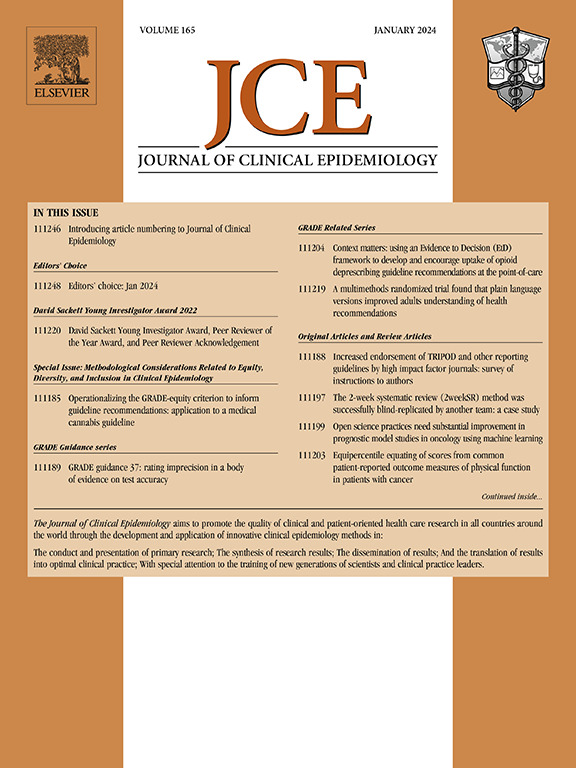Using methods to extend inferences to specific target populations to improve the precision of subgroup analyses
IF 7.3
2区 医学
Q1 HEALTH CARE SCIENCES & SERVICES
引用次数: 0
Abstract
Objectives
While subgroup analyses are common in epidemiologic research, restriction to subgroup members can yield imprecise estimates. We aimed to demonstrate how methods extending inferences to external targets improve precision of subgroup estimates under the major assumption effects differ between subgroup members and nonmembers due to measured effect measure modifiers (EMMs) and membership is independent of the effect after conditioning on EMMs.
Study Design and Setting
We applied this approach in the Panitumumab Randomized Trial in Combination with Chemotherapy for Metastatic Colorectal Cancer to Determine Efficacy. Assuming Hispanic vs non-Hispanic ethnicity was independent of the effect conditional on measured EMMs, we weighted non-Hispanic White participants to resemble Hispanic participants in EMMs, assigned Hispanic participants weights of 1, and estimated weighted 9-month progression-free survival differences (PFSDs) with 95% confidence limits from 2000 bootstraps. We also explored outcome-based approaches. Finally, we examined a situation where the method generates biased estimates (targeting participants with mutant-type Kirsten rat sarcoma virus (KRAS), which determines efficacy).
Results
While the Hispanic participant-only analysis estimated a 9-month panitumumab PFSD of −7.1% (95% CI −32%, 19%), the weighted combined estimate targeting Hispanic participants was much more precise (−3.7%, 95% CI: −16%, 9.2%). Other analytic approaches yielded similar results. Meanwhile, the weighted combined estimate targeting mutant-type KRAS participants appeared biased (−2.2%, 95% CI: −7.5%, 3.3%) vs the subgroup-only estimate (−11%, 95% CI: −18%, −2.3%).
Conclusion
While extending inferences from study populations to specific targets can improve the precision of estimates in small subgroups, violating key assumptions creates bias for many subgroups of interest.
Plain Language Summary
Understanding the benefits and harms in specific subgroups of patients is an important part of epidemiologic and public health research. Unfortunately, commonly used methods to do subgroup analyses can result in estimates with lots of uncertainty. Repurposing methods that have traditionally been used to “generalize” or “transport” effect estimates from specific studies to the types of patients more likely to be encountered in the real world could be used to obtain more informative estimates in subgroups without ignoring differences between different types of patients. In this project, we applied this strategy to the Panitumumab Randomized Trial in Combination with Chemotherapy for Metastatic Colorectal Cancer to Determine Efficacy (PRIME) to create much less variable estimates of the treatment effect in Hispanic participants without ignoring the fact that there were more Hispanic participants with a tumor variation that changed the effect of treatment. On the other hand, when we tried to apply this strategy to improve estimates in patients with that tumor variation, we ended up with a misleading effect estimate. While these methods can reduce uncertainty about the benefits of treatment in specific subgroups interesting to researchers, they can result in incorrect subgroup estimates when their assumptions are violated.

求助全文
约1分钟内获得全文
求助全文
来源期刊

Journal of Clinical Epidemiology
医学-公共卫生、环境卫生与职业卫生
CiteScore
12.00
自引率
6.90%
发文量
320
审稿时长
44 days
期刊介绍:
The Journal of Clinical Epidemiology strives to enhance the quality of clinical and patient-oriented healthcare research by advancing and applying innovative methods in conducting, presenting, synthesizing, disseminating, and translating research results into optimal clinical practice. Special emphasis is placed on training new generations of scientists and clinical practice leaders.
 求助内容:
求助内容: 应助结果提醒方式:
应助结果提醒方式:


